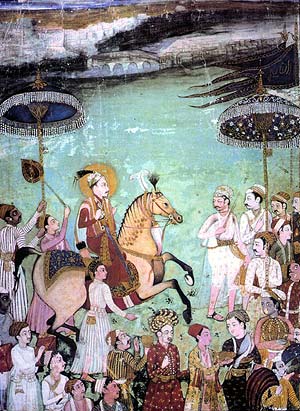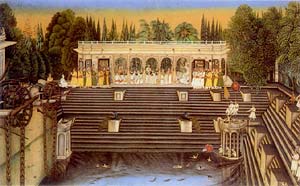| The Realm of Kings | The Hunt | Court Life | Kings, Courtiers, and Women | Courtly Manuscripts | The Realm of Gods | |||||||||

Sultan 'Abdallah Qutb Shah in procession
Golconda, Deccan; 1635-40 Opaque watercolor and gold on paper Cynthia Hazen Polsky Collection (2040-IP)

Maharana Bhupal Singh of Mewar with courtiers at a tank
Udaipur, Rajasthan; ca. 1930-35 Opaque watercolor and gold on paper Cynthia Hazen Polsky Collection (8060-IP) |
Court Life Scenes of court life—royal processions and assemblies or domestic groups—tend to be idealized and conventional in treatment, similar to contemporary literary descriptions of such scenes. Rendering a detailed, first-hand account of events at a specific, historical court was one of the innovations of Mughal painting in the late sixteenth century. At the dynamic studio of Akbar (r. 1556–1605), the most gifted painters learned their art from newly available European models as well as from more traditional sources. In the outlying kingdoms of the Deccani sultans from the sixteenth to the seventeenth century and of the Rajput maharajas from the late seventeenth century onward, a more rounded and often more relaxed picture of court life is presented in paintings. In Rajasthan, patrons such as Maharana Amar Singh II and his successors at Udaipur encouraged their artists to portray daily court life—sometimes also including more private moments in the company of ladies—in unprecedented, almost documentary detail. |